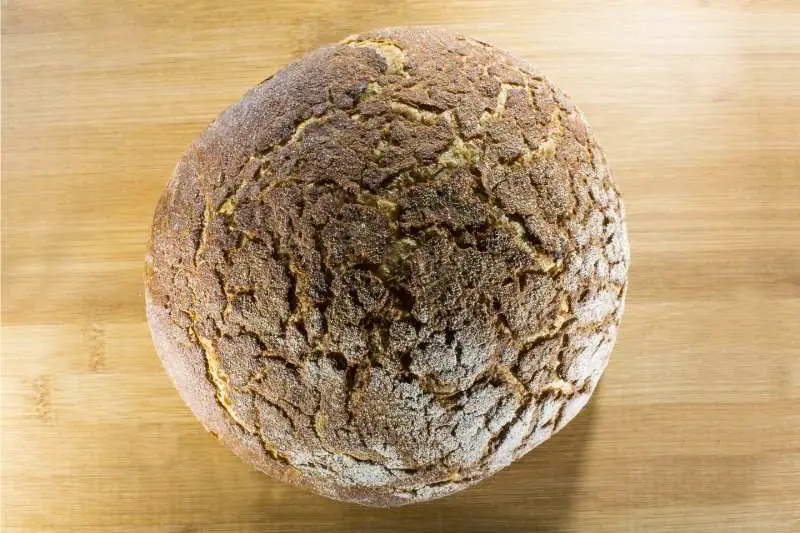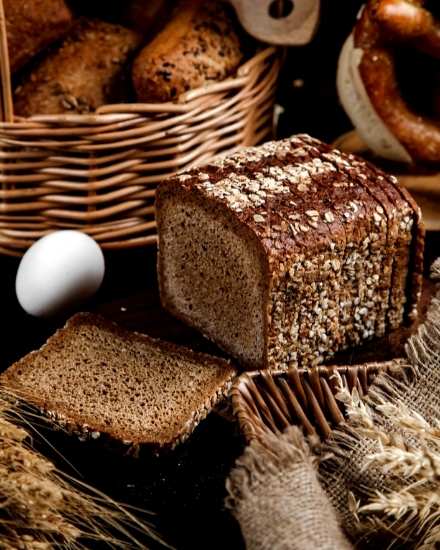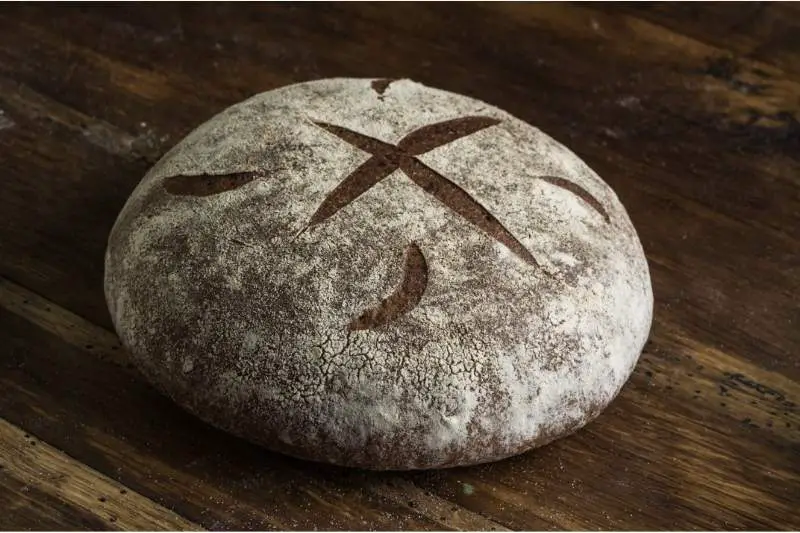This post contains affiliate links.
Making bread is one of the most comforting activities a home cook can master. Homemade bread has an extra level of warmth and enhanced taste that store-bought bread cannot begin to achieve. However, if you are new at bread baking, making the perfect loaf of bread may have some challenges. A frequent source of confusion for new bread makers is the occasional gray bread or gray dough.
As a general rule, your bread dough is gray in color because the dough was untouched for a few days. When bread dough is left out for too long, it develops a gray coarse layer that has a tough and leathery texture. Gray bread is safe to consume, however, it will taste different if not fixed.
Fortunately, if your dough or bread is gray in color, there is an easy way to fix that! With a bit of investigation, I discovered how to get my bread back to being fresh again. Knowing this will help you enjoy your homemade bread without any more inconvenient gray colorization.
Why Is My Bread Gray?
Your bread can turn gray because of improper storage, poor ingredients, too much moisture, or mold in the dough. Because of these reasons, the dough can form a coarse gray layer that will need to be fixed. If the dough is left unfixed, the bread will have a tough, and chewy texture.
If your bread is gray, it is likely due to one of four reasons:
- Improper Storage
- Poor Ingredients
- Moisture
- Mold
While some of these can be corrected by making sure you are following the recipe correctly, others may only be corrected after examining your cooking techniques.

*Side Note: I recently wrote an article that talks about How To Store All Types of Baking Yeast. This article breaks down exactly what you need to do to store your opened unused yeast to keep it fresh for longer. You can check out this article here!
You Didn’t Properly Store the Bread Dough
What Types of Improper Storage Can Cause Gray Bread?
If too much moisture gets to your dough when it is proofing, your bread may turn gray. This may be due to the dough being stored incorrectly. If you failed to cover the dough tightly or kept the dough in the refrigerator for longer than three days, your dough may be too moist and may result in gray bread.
One tip that I use when I am baking bread is to store any dough in the freezer if I think I am going to have problems baking it within three days. In the freezer, the dough can typically last for up to 14 days.
You Used Poor Ingredients
If you use the wrong type of salt or old flour, it can cause your bread to turn gray. In the case of salt, you may experience gray bread if you use a salt that has iodine included. Many types of table salt include iodine, so if you are using table salt, you may end up with gray bread.
Types of salt to include in your bread baking instead of table salt include:
- Kosher salt
- Himalayan pink salt
- Sea salt
- Non-iodine table salt
For bread baking, I typically stay away from table salt that has iodine in it because I find that it leaves a bitter taste. Using other types of salt keeps my bread from turning gray and also does not have that bitter aftertaste that iodized table salt often brings to the bread.
Another way that poor ingredients can affect your bread and turn it gray is the presence of old flour. The types of flour that you purchase in the store are often sitting on the shelves for months at a time.
Additionally, we often leave flour in our pantry for months. Old flour can result in a dough that is gray in color.
Ideally, you should keep flour in the pantry for no longer than eight months!
*Side Note: I recently wrote an article that breaks down Can You Use Bread Flour To Bake Cookies. This article talks about what you should expect when Baking Cookies With Bread Flour. You can check out this article here!
Your Bread Dough Has Mold On It
How Can You Detect Mold in Gray Bread?
The best time to search for mold in your breadmaking process is when it is still in dough form. Thoroughly examine the dough when you are forming your bread so that you do not miss any signs of mold. Not only will moldy dough have a gray color, but it may also have fuzz on it.
Eating bread that has been baked from moldy dough can be very dangerous, so always be on the lookout – especially if you are working with doughs that require several days worth of proofing.
Your Bread Dough Has Too Much Moisture
How Will Too Much Moisture Cause Bread to Turn Gray?
Both the mixing of the dough and the improper cooling of finished bread can result in too much moisture, which can cause your bread to turn gray. Perhaps you added too much water and not enough flour and ended up with an overly wet dough. That can cause your bread to turn gray, and it will become grayer as you continue to store it.
If you do not allow the bread to cool before you wrap it, the wrapping will trap steam. This steam will create too much moisture, and your bread will become grayer every day.
*By the way, I always wanted to be able to store my bread dough the right way but I never found a good container that could fit a large amount of dough. However, I recently came across an 8 Quart Commercial Grade Clear Storage Square Polycarbonate Containers. This container was perfect for storing my bread dough. You can check out this Storage Container on Amazon!
Why Did My Dough Turn Gray in the Fridge?
If your dough has turned gray after being in the fridge, it is because too much air reached the dough. To prevent your dough from turning gray, make sure as little air gets into the container as possible.
Placing the dough into smaller containers may work, and you can prevent the dough from being exposed to air by wrapping plastic wrap tightly around the top of the dough.

To make sure as little air hits my dough as possible, I often combine sealing methods. I place the plastic wrap around the dough and also place the dough into a sealable container. With this method, my dough does not change colors and becomes an unpleasant shade of gray.
*Side Note: You might also want to know How To Tell When Your Banana Bread Is Done. I recently wrote an article that talks about The Right Way of Fixing Undercooked Banana Bread. You can check out this article here!
How To Store Dough So That It Lasts?
As a whole, to make sure that bread dough will last, you want to store it in a container that does not allow excess moisture or air to reach the dough. Tightly wrap the dough with plastic wrap and put it in a container that has room for the dough to rise.
How long can dough last before turning gray in color:
| Counter Top | Sealed Container | Refrigerator | Freezer |
| Can last for 12 hours if left out at room temperature | Can last for up to 2 days | Can last for 3 days | Can last for up to 14 days |
The best way to store dough is to follow these steps:
- Oil the inside of a mixing bowl
- Place the dough inside the bowl
- Firmly wrap the dough with a plastic wrap
- Make sure that the dough is completely sealed
- Make sure the container has room for the dough to rise
Just like the dough, a loaf of bread is a baked good that needs to be stored correctly in order to stay fresher for longer. As we all know by now, if bread is not stored correctly, it will quickly harden and mold which is what makes it look gray in the first place.
*Side Note: You might also want to know how to Store Your Cake Batter The Right Way. I wrote an article about Storing Cake Batter The Right Way, which you can check out here!
How Long Does Dough Last in the Fridge?
Typical dough can last for three days in the fridge. Some doughs may last longer, and can still be good after up to 10 days in the fridge. Dough that contains eggs or milk will not last as long as other doughs. Make sure that the dough had enough time to rise before placing it inside a freezer.
How Long Does Dough Last in the Freezer?
As a whole, typical dough can last for up to three months in the freezer. After the dough cools down, tightly wrap it in plastic wrap and place it in an airtight container. Make sure that the dough had enough time to rise before placing it inside a freezer.
How to Tell If Dough Has Gone Bad?
As a general rule, dough that has gone bad when it will have a bad smell, unpleasant look, and undesirable texture. The first sign that dough has gone bad should be the smell. A bad dough will have an overly fermented smell, which should remind you of the smell of alcohol.
If the dough has a strong fermented smell, it will not taste good when you make it. It may be safe to eat, and you may not get sick from it. But it will not have the delicious fresh bread taste that you crave.
Dough that has gone bad may also look unpleasant. It may be a dull, drab shade of gray.
Your dough may also be extra crumbly when you remove it from its storage container. If the texture feels “off” in any other way, the dough may also have gone bad.
*By the way, you might also want to know Does Carrot Cake Spoil. I recently wrote an article that talks about The Right Way to Store Carrot Cake to Make It Last. You can check out this article here!
Don’t Mistake Rye Bread For Gray Bread
While your dough could turn out to be gray in color, you should not mistake it as a bad thing depending on the type of bread that you are making. There are several different types of gray loaves of bread that could be made.
Rye bread is amongst the most popular bread that people decide to make which usually turns out to be gray in color. If you want to make gray bread, you would be using rye flour with white flour while making the dough.

*By the way, storing your bread the right way has proven to be the most effective way to make it last. When I store my bread on the countertop, I usually use an Extra Large Black Bread Box That Holds 2+ Loaves at a Time. It keeps just enough air out to keep the bread fresher for longer. You can check out this Bread Box on Amazon!
FAQs:
Why Does My Bread Look Dull?
If your bread turns out dull, you may not have given the yeast enough time to break down the flour. Without this process, the sugars needed to turn the bread a golden brown will never happen. Avoid this mistake by allowing the dough to sit on the counter for at least 30 minutes before you place it in the refrigerator.
Why Didn’t My Bread Brown on Top?
As a general rule, your bread didn’t brown on top because you may have the oven at too low of a temperature, or too much steam may have occurred during the cooking process. You may have also needed a wash to brown the outside crust, or you may have not proofed the dough correctly.
Why is Bread Not White?
If your bread is not turning out white, consider the following possible reasons:
- Your flour was too old
- Your flour had a low protein content
- The dough needed a longer proofing time
- The dough was not kneaded long enough
- Your yeast died because it was too hot
Why Does Sourdough Bread Crumb Turn Grey in Color?
As a general rule, sourdough bread crumb turning grey in color is a natural result of using rye flour. When you use rye flour combined with white flour, the result will be grey bread crumbs or streaks. If you wish to prevent gray crumbs, do not use rye flour.
To Summarize…
While dough can turn gray in color because of improper storage, try not to mistake it with actual rye bread that is usually gray. Rye flour makes the bread gray after it is baked.
Bread making is usually a very delicate process and requires a gentle touch. Every ingredient that goes into making dough has a role to play. However, storing the dough is where some bakers make the mistake of letting it sit out for too long.
